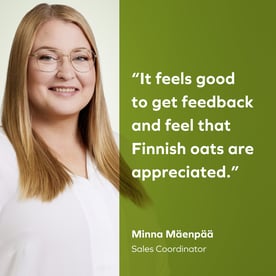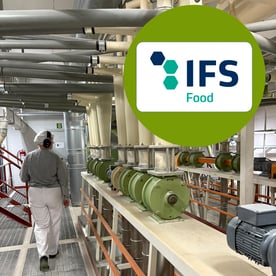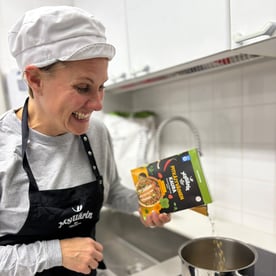Satellite imagery guides precision fertilisation of Oats 2.0
In Ilmajoki, the summer day is long during the Midsummer week. After the heat of May and the rains of June, Oats 2.0 is growing fast in the field. After the flag leaf, it's time for the flower.
– Ongoing precision fertilization will also reduce the need for straw adjustments and disease control, says contract farmer Mikko Mäki-Latvala.
When we last spoke to Mikko, the sowing of the second harvest season of One Farm Oats 2.0 was still in progress. However, winters and floods quickly became a thing of the past in Ilmajoki, too, as the long heatwave in May boosted oat growth.
– The oats stood up well to this heatwave. Normally, you don't see this kind of sunny warmth in May. Green shoots are easily affected by drought, but this time the oats sprouted well. At this point it was to our advantage that the winter vegetation cover kept the fields moist for a long time.

Precision fertilization for the oat field.
Mikko admits that after a couple of weeks of heat, the anticipation of rain at the Mäki-Latvala farm was dreadful. At one point, two rain fronts passed the farm, but the Oats 2.0 fields were left dry in between. The three weather stations are monitored with a keen eye throughout the growing season in order to be proactive.
– It is said that oats grow with water, but oats are more drought tolerant than barley, for example. Luckily, the skies opened on the first day of June. Since then, it has rained every day, but not too much. Good soil structure can withstand both drought and rainfall. We are happy to accept the rains, even if they affect the work in the fields.
AN IMPORTANT GROWTH PHASE: FROM THE SIZE OF A MATCH TO HALF A LEG IN HEIGHT
In Midsummer week, according to Mikko Mäki-Latvala, expectations for the Oats 2.0 harvest are high - especially when compared to the 2023 harvest season.
– A year ago, the green shoots were more even. However, the side shoots did not arrive on time due to the cold weather and the lack of rains that are important for growth. Then, when the faucets opened later in the summer, the lammas shoots came. So, at the threshing stage, there were two or three different generations of oats in the same field," recalls Mikko.
By Midsummer week 2024, the vegetation is of uniform quality.
– Of course, this is a stressful time for oats. The straw growth phase is underway, with the still hidden flag leaf due in a week or so. Then it is time for the oat flower, panicle, to emerge.
20 June is a long summer day in Ilmajoki. Significantly longer than in, for example, the capital region or Tampere.
– Oats are now growing rapidly in length. The challenge for oats that have already grown to knee height is to stand up later. If the straw buckles, the grain size is in danger of becoming small and the grains are threatened by mould toxins. Precision fertilization helps here too, to minimise straw difficulties and disease control.
Watch the video to hear from Mikko while he is fertilizing the fields (in Finnish).
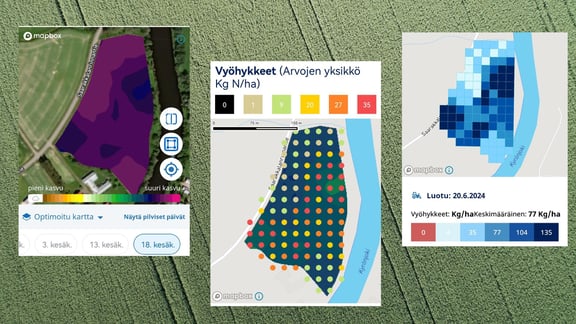
The fertilisation plan shown in the middle is based on the crop/biomass map on the left. This is used to create a final application map, visible on the right, on the basis of which the Trimble driving guidance system commands the fertiliser spreader on a site-specific basis.
THE SATELLITE SAYS IT ALL: THE RIGHT PLACE AT THE RIGHT TIME
On Midsummer's Eve, Mikko Mäki-Latvala goes to the banks of the Kyröjoki, to the Oats 2.0 field, to fertilise it. Two days earlier, on 18 June, a satellite imaged a crop map of the field, providing accurate information for precision fertilisation.
– Traditionally, the same amount of fertiliser is applied everywhere. We don't go out into the field until we have an accurate picture of the situation from satellite imagery. The challenge with satellite imagery is cloudy days, when you can't see the amount of vegetation in the images. Sometimes you have to switch between different temperatures, sometimes you have to combine information from different descriptions.
The satellite images the Oats 2.0 field every two to three days.
– Based on the biomass map from the satellite images, we create a fertilisation plan and, based on that, an application map, according to which the Trimble driving guidance system commands the fertiliser spreader on a site-specific basis," says Mikko.
– The crop map shows where additional fertiliser is needed and where the plant cannot use it. The fertiliser actually goes into the crop and does not run off into the environment. On this 3.3-hectare plot, an average of 77 kg/ha means in practice that a few spots receive 4 kg/ha of fertiliser, while in very close areas the fertiliser requirement is as high as 135 kg/ha.
YES TO LADYBUGS, NO TO PESTICIDES
On the Mäki-Latvala farm, the term "weather reservation" has a completely different meaning from what people enjoying their summer vacations are used to. In Ilmajoki, the weather reservation means that whenever the weather allows, the machine moves. On Midsummer's Eve, the delicate flower buds of turnip rape were scheduled to receive their share of plant protection measures in the morning, but a 5 metres per second wind postponed the work in the turnip rape field until the calmer evening shift.
No pesticides are used in the cultivation of Oats 2.0. To combat the worst pest of oats, the bird cherry-oat aphid, we enlisted the help of their natural enemies: the ladybugs. One ladybug can eat thousands of bird cherry-oat aphids during its lifetime.
– The bird cherry-oat aphid does not damage oats, but it spreads Barley Yellow Dwarf Virus into the oat field, which kills the oats. We actively monitor the bird cherry-oat aphid forecasts made by the Natural Resources Institute Finland. Now the weather is on our side and against aphids, so we are hopeful that the crop will also be spared from Barley Yellow Dwarf Virus.
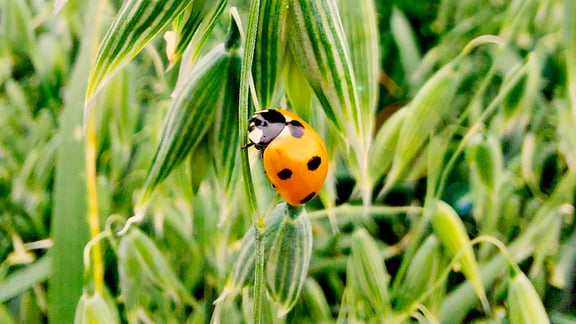
To combat the worst pest of oats, the bird cherry-oat aphid, we enlisted the help of their natural enemies: the ladybugs.
Mikko Mäki-Latvala would like to remind everyone that plant protection is not the same as the use of pesticides.
– Crop protection is about the correct nutrient balance during the growing season, in which both macro- and micronutrients play a role. Even if we are only talking about grams of zinc, boron and manganese, for example, the lack of a small essential nutrient can limit yields. When everything seems to be in order, suddenly the manganese deficiency jumps out at you. The amount of nitrogen and phosphorus does not help. Manganese is the most critical factor for oats: even 0.04 grams per square metre can save the crop, Mikko Mäki-Latvala says, knowing this from experience.
We will visit the Mäki-Latvala farm again at threshing time
What on earth is Oat 2.0? Read more!

